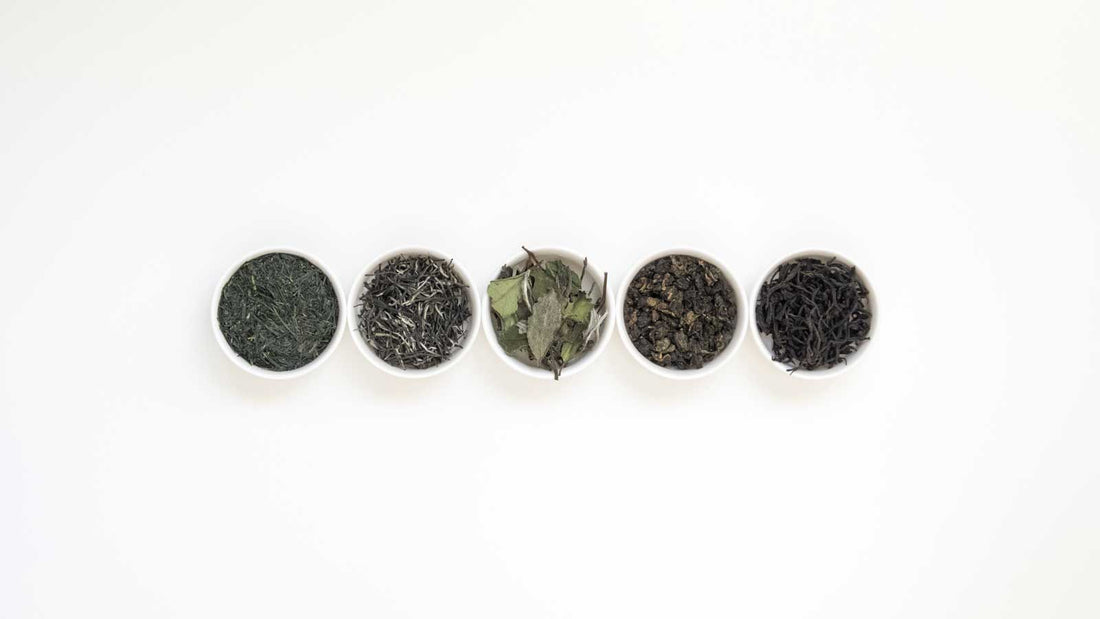We are going on an adventure with the Vol. 6 Exploration Kit. In the kit, you'll find two green teas, a white tea, an oolong tea and a black tea. Not only are they from three different regions, you will find that the teas represent a broad spectrum - from sweet to savoury and from well-known to the under-represented. Are your senses ready? Check out our tea stories below to learn more about what's in your cup.
Lu Shan Yun Wu
Gyokuro
Cold Dew Shou Mei
Honey Oolong
Huang Guan Yin Black
Here's a map to give you an idea of the journey this Exploration Kit will take you. Locations are approximate and intended to serve as a visual guide only.
Lu Shan Yun Wu

盧山雲霧
Green Tea
Spring 2021
Lu Shan, Jiangxi, China
The mist and cloud of Mt. Lu, just its name already paint a great picture of its pristine growing environment, which is perfect for tea cultivation. This explains why Lu Shan Yun Wu has been a tribute tea since the Song Dynasty and continues to be sought-after.
Notes: Vegetal, Savoury
Gongfu:
5g | 100ml | 80c | 20 secs
Western:
4g | 250ml | 80c | 1 min
This Lu Shan Yun Wu is harvested and processed on Jiangxi's family farm. The tea has a sweet/savory taste and a hint of vegetal note to it. We also enjoyed the slight viscosity that is not common in some other green tea. We also welcome the tiny bit of astringency that gives off a good kick on the finish.
The story of Lu Shan Yun Wu
Lu Shan has been a tea-growing region dating back to the Han Dynasty (202BC – 220AD) and became a tribute tea in the Song Dynasty. It’s also loved by scholars and poets as there are many records of written works related to Lu Shan tea. Lu Shan Yun Wu first appeared in the Ming Dynasty. Riding on the waves of Hongwu Emperor’s insistence on favoring loose leaf tea over tea cake in the Ming Dynasty, Lu Shan Yun Wu quickly gained national recognition. To this day, Lu Shan Yun Wu remained one of the Top Ten tea in China and is loved by people worldwide.
Gyokuro

玉露
Green Tea
Spring 2021
Yame, Fukuoka, Japan
Spring is when some of the most prized teas are made and that’s no exception when it comes to Japanese teas. Gyokuro or “Jade Dew” is one of the highest-grade Japanese loose-leaf teas and is best known for its rich and umami flavours.
Notes: Savoury, Marine
Western:
3g | 200ml | 70c | 2 mins
This Gyokuro is from Yame, located in the Fukuoka Prefecture on Kyushu Island. The optimum climate, pure mountain waters, and enriched soil make Yame one of Japan’s renowned tea-producing regions. In fact, Yame won the Regional Award at the 75th All-Japan National Tea Competition in November 2021 under the Gyokuro category.
The story of Gyokuro
Gyokuro, first created in 1835, was believed to have been discovered by chance when a tea merchant, Yamamoto Kahei VI went to Uji to study Tencha (the shaded tea commonly used for matcha) production. Seeing that the tea plants were covered to protect them from frost, he applied the shading method to Sencha production. The results were a richer and sweeter tea liquor and the birth of Gyokuro!
To produce Gyokuro, tea plants must be shaded for about 20 days before harvesting. One of the biggest benefits of shade-growing is that the tea plants retain a greater amount of L-theanine amino acid, the key chemical component responsible for the umami flavour. To ensure this sought-after characteristic of Gyokuro is best presented, it is recommended to brew the tea with cooler water.
Cold Dew Shou Mei

寒露壽眉
White Tea
Autumn 2021
Fuding, Fujian, China
More and more people are falling for white tea, for its subtle but uplifting and refreshing flavor. Interestingly enough, you would often hear people talking about Silver Needle and White Peony fondly, but hardly any mentions about Shou Mei.
This is precisely why we are including it in our Tea Exploration – Meet Shou Mei, the dark horse in the White tea family.
Notes: Stone fruit, Sweet
Gongfu:
4g | 100ml | 90c | 5-10 sec
Western:
3g | 250ml | 80c | 1 min
This Shou Mei is harvested around Cold Dew (寒露), one of the 24 Chinese Solar Terms, in October 2021. Cold Dew indicated a further drop in temperature, with morning dew reaching freezing point. (露氣寒冷,将要凝结也) In this type of weather, Tea leaves tend to grow slower and develop more flavour combating the harsher conditions. Furthermore, due to the milder wintry sun, you will find much greener leaves with higher chlorophyll content, which further enhances the flavour of the tea.
The story of Shou Mei
With a high leaf to bud ratio, Shou Mei has gotten its name 壽眉 “longevity eyebrow” because it resembles an old man’s eyebrow. Its production is made up of more than ½ of the White Tea production in Fujian, and it’s one of the teas you would often find at dim sum restaurants. It is a popular tea choice to age because it has higher phenolic content which facilitates the transformation thru time.
Even though it doesn’t get the well-deserved mention often, with its friendly price tag and a fuller body, Shou Mei is surely a tea you should not miss.
Honey Oolong


蜜香烏龍
Oolong Tea
Spring 2021
Mingjian, Nantou, Taiwan
Do you love tea with a sweet profile? Even better if it’s naturally sweetened. This is why we love the famous bug-bitten tea from Taiwan. Who would have expected a self-defense mechanism from the tea plants would result in this intoxicated nectar-like flavour. This tea is truly another gift of nature.
Notes: Floral, Honey
Gongfu:
5g | 100ml | 90c | 30 secs
Western:
3g | 250ml | 90c | 2-3 mins
This Honey oolong tea is harvested and processed in Mingjian Taiwan, a tea district that yields the largest tea production due to its suitable climate and soil composition. With an influx of Immigrants from Fujian in the Qing Dynasty (1700s) bringing with them the tea processing skills and tea plants, Mingjian naturally developed into one of the important tea-producing provinces of Taiwan.
The story of Bug-Bitten Tea
Oriental Beauty is the first bug-bitten tea that has stolen hearts globally due to its nectar-like flavour. This bug bite “technique” was harnessed in Taiwan when a tea farmer had a major bug-infested harvest. Luckily, he tried to see if anything could be salvaged and went through the tea processing which he turned a disaster into a beautiful discovery of the whole new honey nectar note. Later investigation revealed the tea hopper bites triggered the release of certain compounds in the tea leaves, which were meant to attract spiders that prey on the little bugs. This compound is what made up the wonderful honey note we love.
This technique has now been applied to other tea and tea type that are not as tricky to produce as Oriental Beauty, so we get to enjoy more of this nature’s wonder.
Goddess (Huang Guan Yin) Black

黃觀音紅茶
Black Tea
Spring 2021
Wuyishan, Fujian, China
What does black tea remind you of? A cozy, warm hug full of malty and robust flavour. If that’s what you’d expect, you might have to reset your taste bud when brewing up a Goddess (Huang Guan Yin) Black tea. Be prepared for a floral, sweet, and somewhat uplifting session if you are looking for a different black tea experience.
Notes: Floral, Sweet
Gongfu:
5g | 100ml | 98c | 15 secs
Western:
4g | 250ml | 90c | 2 mins
This Goddess Black tea is from Wuyishan, the home of Yancha and Xiaozhong. Being one of the newer cultivars in town, it has offered a different perspective that we found rather enjoyable. After all, who does not enjoy a tea that brews up like a bouquet?
The story of Huang Guan Yin
A little tea Frankenstein, the Huang Guan Yin was born at the Fujian Academy of Agricultural Sciences in 1998, after years of research and planting experiments.
A hybrid between two Anxi tea varietals, Huang Jin Gui 黃金桂 and Tie Guan Yin 鐵觀音, Huang Guan Yin truly shines through with its exhilarated aroma, the “sky punching aroma” (通天香) characteristic coming from Huang Jin Gui. With the higher yield and resiliency against harsh weather, it became a welcoming cultivar for tea farmers. Some people might argue that it is not the indigenous varietal for Wuyishan, but more people are welcoming this aromatic tea, especially as a summer brew in both hot and cold.

